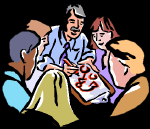Active Learning
"Learning is not a spectator sport. Students do not learn much just by sitting in class listening to teachers, memorizing prepackaged assignments, and spitting out answers. They must talk about what they are learning, write about it, relate it to past experiences, apply it to their daily lives. They must make what they learn part of themselves."
--Arthur W. Chickering and Zelda F. Gamson, "Seven Principles for Good Practice," AAHE Bulletin 39: 3-7, March 1987
--Arthur W. Chickering and Zelda F. Gamson, "Seven Principles for Good Practice," AAHE Bulletin 39: 3-7, March 1987
What Is Active Learning?
Active learning is a student centered approach in which the responsibility for learning is placed upon the student, often working in collaboration with classmates. In active learning teachers are facilitators rather than one way providers of information. The presentation of facts, so often introduced through straight lecture, is deemphasized in favor of class discussion, problem solving, cooperative learning, and writing exercises (graded and ungraded). Other examples of active learning techniques include role-playing, case studies, group projects, think-pair-share, peer teaching, debates, Just-in-Time Teaching, and short demonstrations followed by class discussion.
There are two easy ways to promote active learning through the discussion. The first method is the mini lecture format in which the instructor talks ten to twenty minutes about a particular topic and then pauses for students to consolidate their notes, find gaps, and work with classmates to fill in gaps. The second technique is an active listening lecture where students just listen to a lecture without writing notes and then, after ten to twenty minutes, the student works with a classmate or small group to recall, clarify, and elaborate on the lecture's content.
In the section below, click on the links to find examples of active learning strategies described in SERC's Teach the Earth web site.
Examples of Active Learning Techniques
- Think Pair Share: students ponder the answer to a question and then share their thoughts with a neighbor.
- Role Playing: "each student takes the role of a person affected by an Earth science issue, such as a volcano or a polluted lake and studies the impacts of Earth science issues on human life and/or the effects of human activities on the world around us from the perspective of that person."
- Discovering Plate Boundaries (more info) : this is a group discussion method employing many aspects of cooperative learning. In the example cited here, students use the "Jigsaw" technique to learn more about plate tectonics. For a more general discussion of cooperative learning see the module on Cooperative Learning.
- Peer Review: students review and comment on materials written by their classmates.
- Discussion: promoting a successful discussion depends on correctly framing questions. Discover tips for framing discussion questions to promote higher order thinking.
- Role Playing: students look at the topic from the perspective of a character, who will affect and be affected by a chosen topic.
- Problem solving using real data: students use a variety of data to explore scientific questions.
- Just in Time Teaching: students read assigned material outside of class, respond to short questions online, then participate in collaborative exercises the following class period.
- Game Based Learning: uses competitive exercises, either pitting the students against each other or through computer simulations.

